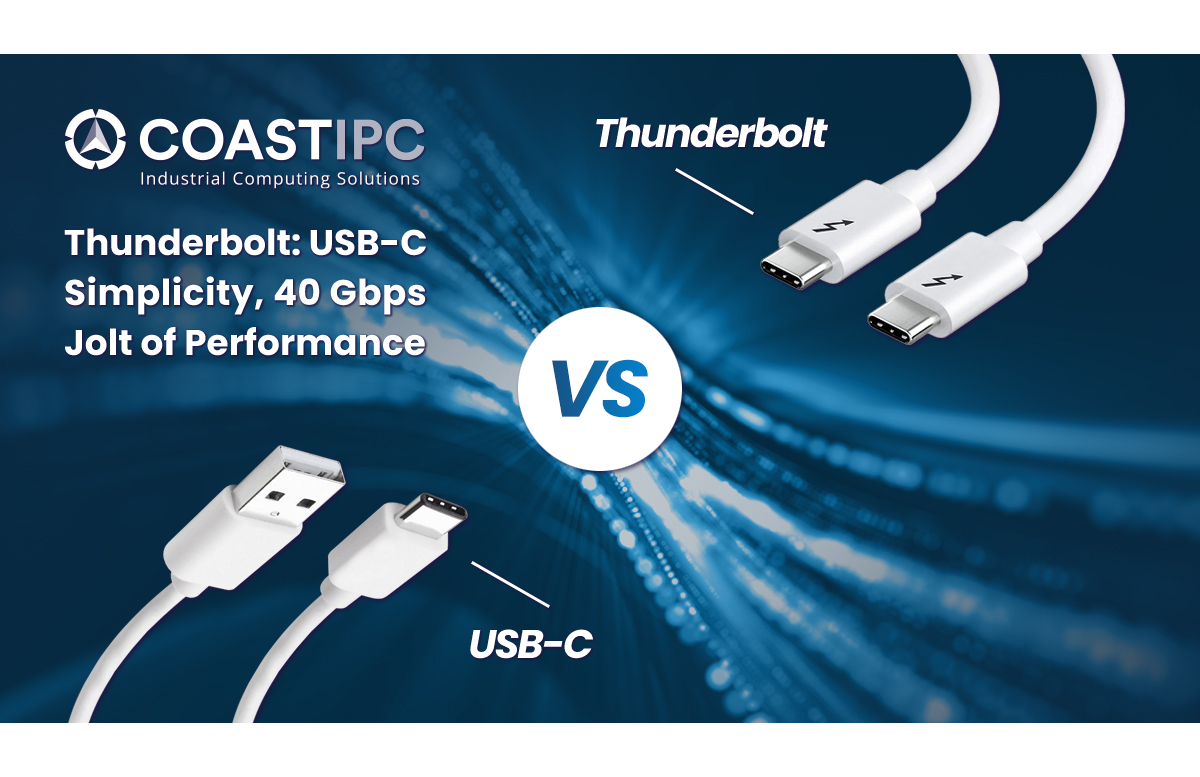
USB connectivity has been present in our computing lives since the late 1990s, and the interface has become the most versatile connectivity option in modern-day computing. The most recent evolutions in the standard have resulted in increased bandwidth capability of up to 20 Gbps and the addition of a modern, rotationally symmetrical connector known as USB Type C, or more commonly as USB-C or Type-C.
While this is great news for users of consumer electronics and end-user peripheral devices, what about those in the industrial computing space who have more extreme demands in terms of acquiring or transferring data, driving 4K or 4K video output, or wanting to daisy-chain multiple devices? Enter Thunderbolt: the versatility of USB-C with unmatched speed and performance capabilities.
The Same, Only Different
While current versions of Thunderbolt and USB-C use the same oval-shaped 24-pin connector and share several traits, the two contain a number of differences that set them apart from each other. USB is an interface capable of transferring data at up to 20 Gbps (depending on port and cable specifics) and is widely deployed across most peripheral devices today — phones, tablets, and external hard drives to name a few. The interface is also capable of powering and/or charging those same devices for added convenience and simplicity. Its plug-and-play architecture makes it a natural choice for connecting peripherals to a PC.
Thunderbolt is a protocol codeveloped by Intel and Apple for the purpose of transferring large amounts of video and data. On the surface, Thunderbolt looks just like USB-C, and the easiest way to identify a Thunderbolt port is to look for the lightning bolt symbol next to or near the physical port on your device. It provides for data transfer rates of up to 40 Gbps to support the most demanding applications and like USB-C, supplies power over its cable. Added in is off-the-shelf support for DisplayPort, enabling you to connect up to two 4K displays to a Thunderbolt interface. Unlike USB’s point-to-point architecture, up to six Thunderbolt devices can be daisy-chained together extending the reach and flexibility of a single port. For additional benefit, Thunderbolt is also backward compatible with USB — if you connect a USB device to a Thunderbolt port it will work just fine, albeit at USB data rates and performance.
Interface Ubiquity Leads to Simplicity
In today’s computing world, particularly industrial computing, system designers are constantly in search of small, power-efficient, and cost-effective solutions that don’t sacrifice quality, performance and overall capability. With a common connector between Thunderbolt and USB-C, an opportunity exists to consolidate the physical number of ports on a device without limiting flexibility or connectivity options. This provides excellent potential in the industrial PC (IPC) market where traits such as small form factor and conduction (fanless) cooling carry value for their suitability in harsh working environments but not necessarily at the expense of flexibility and feature set.
The Type-C connector’s ubiquity and multiprotocol compatibility permits a reduction in the number of physical connections on an IPC without requiring users to choose one interface over the other. Similarly, because of its backward compatibility with USB, system designers have the option to future-proof computing solutions for greater data and video performance by standardizing with Thunderbolt even if USB-C meets current requirements.
Find the Right Fit
Choosing Thunderbolt over USB-C adds modest cost to system design so it may not be the right choice for every application. Before investing in the technology, care should be taken to ensure that your IPC is capable of supporting the increased processing demands that Thunderbolt’s data rates can place on the system. System designers and OEMs have myriad choices when it comes to interface connectivity, computing, and cabling solutions and often, enlisting the help of experts in the field is the best way to ensure that you are making the right choices for your project.
CoastIPC offers a wide range of industrial computing solutions from major manufacturers such as Neousys and Advantech as well as custom and value-added solutions and services. Relying on a number of products supporting Thunderbolt and USB-C, the professionals at CoastIPC can work with you to understand your application and to propose a computing solution that meets your unique needs, requirements, and budget.
For more information about interface and connectivity options and the best fit for your industrial computer application, please contact our product experts at [email protected] or 866-412-6278.
